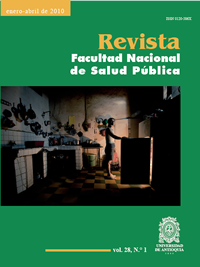Remoción del carbono orgánico disuelto en humedales piloto de flujo subsuperficial y superficial
DOI:
https://doi.org/10.17533/udea.rfnsp.1849Palavras-chave:
tratamiento de aguas residuales, humedales construidos, macrófitas, carbono orgánico disueltoResumo
Objetivo: comparar las remociones del carbono orgánico disuelto (COD) obtenidas con humedales piloto de flujo subsuperficial (HPSS) y de flujo superficial (HPS) mediante Phragmites australis, usado como alternativa de tratamiento para aguas residuales domésticas de pequeñas comunidades y zonas rurales. Metodología: se realizó un estudio de tipo exploratorio experimental adicionando 100,12 mg/L. de carbono orgánico disuelto en agua sintética contaminada con Clorpirifos, con la que se alimentaron los humedales. Se efectuaron 20 muestreos, 16 de ellos para cuatro experimentos y los restantes, en los intervalos en que no se agregó plaguicida. Se tomaron muestras los días 1, 4, 8 y 11 en los seis humedales, tres de ellos subsuperficiales y tres superficiales. La principal variable respuesta fue carbono orgánico disuelto, medida en el analizador de carbono orgánico. Resultados: con los dos tipos de humedales se obtuvo alta eficiencia en la remoción del COD: 92,3% con flujo subsuperficial y 95,6% con flujo superficial. Esta alta remoción fue ocasionada por la interacción entre las plantas, la grava y los microorganismos. Conclusión: en ambos tipos de humedales la remoción fue alta y semejante, pero se recomienda utilizar los de flujo subsuperficial porque en los superficiales se desarrollaron algas y biopelículas gelatinosas, y son propicios para el desarrollo de vectores epidemiológicos importantes en salud pública.
Downloads
Referências
(1). Fondo de las Naciones Unidas para la Infancia. El agua potable y el ambiente daño en los planes de desarrollo. Los programas y proyectos municipales para el sector. En: La infancia, el agua y el saneamiento básico en los planes de desarrollo departamentales y municipales. Bogotá: UNICEF; 2006. p. 58-70.
(2). Lara J. Depuración de aguas residuales municipales con hume-dales artificiales. [Tesis maestría] Barcelona: Instituto Catalán de tecnología, Universidad Politécnica de Cataluña; 1999. p. 18.
(3). Ayaz SC. Post-treatment and reuse of tertiary treated wastewater by constructed wetlands. Desalination 2008; 226: 249-255. DOI: https://doi.org/10.1016/j.desal.2007.02.110
(4). Rousseau DP, Lesage E, Story PA, Vanrolleghem P, De Pauw N. Constructed Wetlands for water reclamation. Desalination 2008; 218: 181-189. DOI: https://doi.org/10.1016/j.desal.2006.09.034
(5) Llagas W, Guadalupe E. Diseño de humedales artificiales para el tratamiento de aguas residuales en la UNSMS.Rev. Instituto de investigación FIGMMG 2006; 15 (17): 86-96.
(6). Dangcong P, Barnet N, Delgenes JP, Moletta R. Effect of oxygen supply methods on the performance of a sequencing batch reactor for ammonium nitrification. Water environment Research 2000; 72(2):195-200. Citado por: Vives Fabregas M. SBR Technology for Wastewater Treatment: Suitable Operational Conditions for a Nutrient Removal [Tesis Doctoral] Girona: Universidad de Girona; 2005. DOI: https://doi.org/10.2175/106143000X137284
(7). Wayne WD. Bioestadística. Base para el análisis de las ciencias de la salud. 4ª Edición. México: Limusa Wiley; 2002. p. 684-691.
(8). Bécares E. Función de la vegetación y procesos de diseño de humedales construidos de flujo subsuperficial horizontal y flujo superficial. En: García J, Morató J, Bayona J. Nuevos Criterios para el Diseño y Operación de Humedales Construidos. Barcelona: Ediciones CPET UPC; 2004. p. 51-62.
(9). Lahora A. Depuración de aguas residuales mediante humedales artificiales: La EDAR de los Gallardos (Almería). En: Paracuellos M. Ecología, manejo y conservación de los humedales. España: Instituto de Estudios Almirenses; 2003. p. 99-112.
(10). Rodríguez C. Humedales construidos: estado del arte I. Rev. In-geniería Hidráulica y ambiental 2003; 24 (3): 35- 41.
Downloads
Publicado
Como Citar
Edição
Seção
Licença
Copyright (c) 2021 Ruth M. Agudelo C., Mónica L. Jaramillo G., Gustavo Peñuela M., Néstor J. Aguirre R.

Este trabalho está licenciado sob uma licença Creative Commons Attribution-NonCommercial-ShareAlike 4.0 International License.
El autor o los autores conserva(n) los derechos morales y cede(n) los derechos patrimoniales que corresponderán a la Universidad de Antioquia, para publicarlo, distribuir copias electrónicas, incluirlas en servicios de indización, directorios o bases de datos nacionales e internacionales en Acceso Abierto, bajo la licencia Creative Commons Atribución-No Comercial-Compartir Igual 4.0 Internacional Comercial (CC BY-NC-SA) la cual permite a otros distribuir, remezclar, retocar y crear a partir de la obra de modo no comercial, siempre y cuando se dé crédito respectivo y licencien las nuevas creaciones bajo las mismas condiciones.












 --
-- --
-- --
--